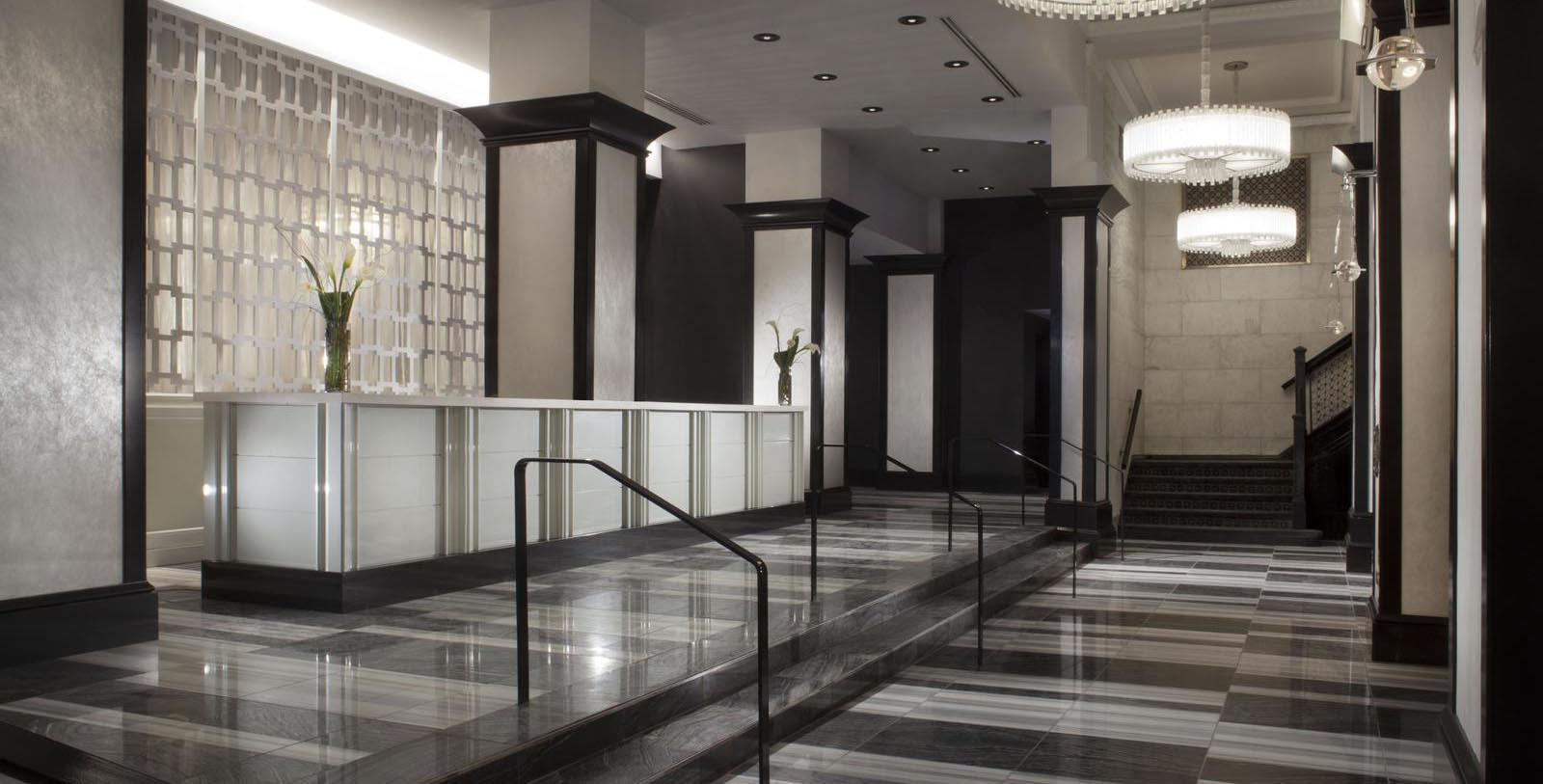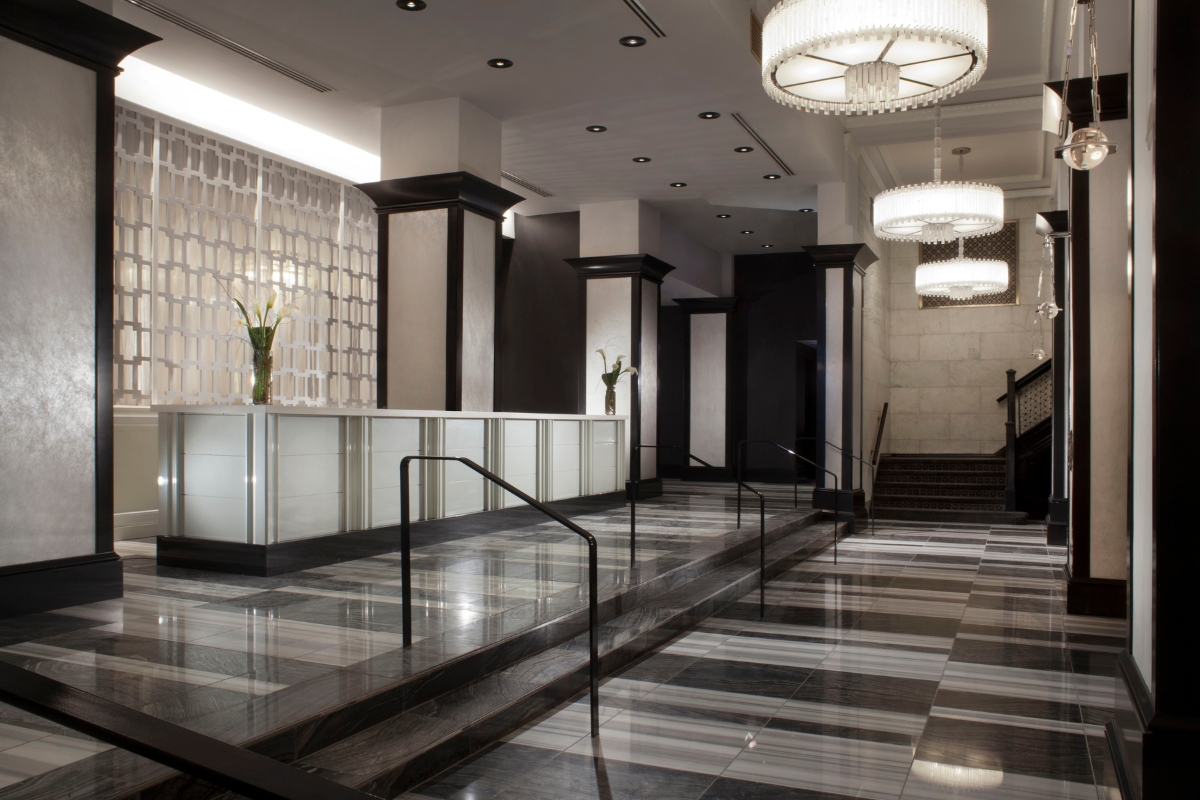Receive for Free - Discover & Explore eNewsletter monthly with advance notice of special offers, packages, and insider savings from 10% - 30% off Best Available Rates at selected hotels.
history
Discover the Silversmith Hotel Chicago Downtown, a rare gem located in the Jeweler's Row District in the heart of downtown Chicago.
The Silversmith Hotel Chicago Downtown, a member of Historic Hotels of America since 2016, dates back to 1897.
VIEW TIMELINEListed on the National Register of Historic Places, the refined Silversmith Hotel Chicago Downtown has been a fixture in Chicago’s Loop district for well over a century. This gorgeous skyscraper is encased with historically unique architecture that still sparkles with the same luxury and eloquence that first defined it at the height of the Gilded Age. Nevertheless, the Silversmith Hotel Chicago Downtown has not always been an upscale retreat. On the contrary, it was once a commercial structure known throughout the city as the “Silversmith Building.” Back during the 1890s, dozens of jewelers began opening shops along a small portion of Wabash Avenue that ran through the center of the Loop. Soon known as “Jewelers Row,” the neighborhood was quickly teeming with all kinds of storefronts and wholesalers. Their arrival eventually heralded a small construction boom that saw the creation of a few new towering buildings. Among the structures to open at the time was the Silversmith Building, which two large jewelry corporations—the Gorham Manufacturing Company and the Benjamin Allen and Company—had commissioned in 1896. Both businesses had agreed to hire architect Peter J. Weber of the D.H. Burnham and Company to design the structure.
Over the next few months, Weber managed to craft a spectacular edifice that displayed some of the best architectural motifs in the Loop. He had specifically decided to use a unique blend of architectural approaches that reflected the transition between the city’s prevailing Romanesque Revival architecture, to the emerging Chicago Commercial style. Consistent with the Chicago Commercial style that developed after the Great Chicago Fire, the building featured more than five stories, large rectangular windows, and a flat roof. But Weber has also incorporated aspects of the earlier Romanesque Revival into the building, too, such as the use of round brick columns and terra cotta tiling. In addition to the Gorham Manufacturing Company and the Benjamin Allen and Company, the building was quickly occupied by a number of jewelers in the weeks following its debut a year later. Tenants were especially drawn to the central light court that permitted ventilation and natural light, which was ideal for hammering silver and crafting elaborate jewelry designs. Nevertheless, the Silversmith Building eventually stopped housing jewelers toward the end of the 20th century and became a luxurious boutique hotel. Now known as the “Silversmith Hotel Chicago Downtown,” this fantastic historic destination still continues to pay homage to its fascinating past.
-
About the Location +
The Silversmith Hotel Chicago Downtown is located in an iconic neighborhood known throughout the world as the “Loop.” While the Loop is now both Chicago’s cultural and commercial center, its history actually harkens much farther back in time. The very first settlers to arrive in the area were the soldiers of the United States Army, who established a rudimentary outpost known as “Fort Dearborn” near the vicinity of today’s DuSable Bridge in 1803. (The DuSable Bridge itself is named for Jean Baptiste Point DuSable, a trader of African descent who built a trading post at the site two decades prior.) Nevertheless, the Potawatomi destroyed the first iteration of the fort during the War of 1812, with the War Department reconstructing it some four years later. A small settlement quickly grew around the second fort by the 1830s, which formed the nucleus of early Chicago’s downtown core over the next several decades. Indeed, the area quickly emerged as the heart of the nascent city’s economy, as many spectacular commercial buildings began to make their glorious debut. One such real estate developer—Potter Palmer—specifically created a number of outstanding structures that ranged from a large emporium to a luxurious boutique hotel. Thousands of people soon found themselves traveling into the neighborhood daily, prompting the city to begin operating a series of local horsecars. Some even found it prudent to construct permanent residences throughout the district and began constructing a variety of upscale townhouses. The population demographic was quite diverse, too, as everyone from Irish immigrants to African Americans started to live all around the site of the former Fort Dearborn. But the spot of the fort—as well as the rest of Chicago—were completely destroyed amid a destructive inferno remembered as the “Great Chicago Fire of 1871.” Like the rest of the city, the area of the former military base was left as a smoldering ruin.
Thankfully, the neighborhood was among the first to rebuild following the tragedy, thanks in large part to the efforts of enterprising entrepreneurs like Potter Palmer. Undeterred, Palmer and a few other ambitious businesspeople invested heavily into the redevelopment of downtown Chicago near the historic fort. They specifically funded the construction of many upscale skyscrapers that finally gave the city its iconic appearance. Furthermore, those local land developers sponsored the creation of a new public transportation network centered around a new technological innovation—the cable car. In fact, two cable-car loops soon became synonymous with the identity of downtown Chicago itself, giving it the new moniker as the “Chicago Loop” or simply the “Loop.” The intersection of Madison and State Street served as the center of the revitalized district, and ultimately, the entire City of Chicago. (This especially was the case following the realignment of the city’s street grid in 1909.) As such, the Loop subsequently established itself as the hub for all economic and social life in Chicago for generations thereafter. Perhaps the height of the Loop’s prestige transpired after World War II, when close to a million people visited the district every day for either business or personal life. While the Loop is no longer the main economic force in Chicago—it shares that distinction with places like the Magnificent Mile—it still very much serves as the cultural heart for the whole metropolis. Countless cultural attractions and historical landmarks call this fantastic neighborhood home, including Willis Tower, Millennium Park, the Art Institute of Chicago, and the Chicago Cultural Center. Cultural heritage travelers will thus find Chicago’s Loop to be among the most illustrious places to visit in the country for a memorable vacation.
-
About the Architecture +
The Silversmith Hotel Chicago Downtown is located in an iconic neighborhood known throughout the world as the “Loop.” While the Loop is now both Chicago’s cultural and commercial center, its history actually harkens much farther back in time. The very first settlers to arrive in the area were the soldiers of the United States Army, who established a rudimentary outpost known as “Fort Dearborn” near the vicinity of today’s DuSable Bridge in 1803. (The DuSable Bridge itself is named for Jean Baptiste Point DuSable, a trader of African descent who built a trading post at the site two decades prior.) Nevertheless, the Potawatomi destroyed the first iteration of the fort during the War of 1812, with the War Department reconstructing it some four years later. A small settlement quickly grew around the second fort by the 1830s, which formed the nucleus of early Chicago’s downtown core over the next several decades. Indeed, the area quickly emerged as the heart of the nascent city’s economy, as many spectacular commercial buildings began to make their glorious debut. One such real estate developer—Potter Palmer—specifically created a number of outstanding structures that ranged from a large emporium to a luxurious boutique hotel. Thousands of people soon found themselves traveling into the neighborhood daily, prompting the city to begin operating a series of local horsecars. Some even found it prudent to construct permanent residences throughout the district and began constructing a variety of upscale townhouses. The population demographic was quite diverse, too, as everyone from Irish immigrants to African Americans started to live all around the site of the former Fort Dearborn. But the spot of the fort—as well as the rest of Chicago—were completely destroyed amid a destructive inferno remembered as the “Great Chicago Fire of 1871.” Like the rest of the city, the area of the former military base was left as a smoldering ruin.
Thankfully, the neighborhood was among the first to rebuild following the tragedy, thanks in large part to the efforts of enterprising entrepreneurs like Potter Palmer. Undeterred, Palmer and a few other ambitious businesspeople invested heavily into the redevelopment of downtown Chicago near the historic fort. They specifically funded the construction of many upscale skyscrapers that finally gave the city its iconic appearance. Furthermore, those local land developers sponsored the creation of a new public transportation network centered around a new technological innovation—the cable car. In fact, two cable-car loops soon became synonymous with the identity of downtown Chicago itself, giving it the new moniker as the “Chicago Loop” or simply the “Loop.” The intersection of Madison and State Street served as the center of the revitalized district, and ultimately, the entire City of Chicago. (This especially was the case following the realignment of the city’s street grid in 1909.) As such, the Loop subsequently established itself as the hub for all economic and social life in Chicago for generations thereafter. Perhaps the height of the Loop’s prestige transpired after World War II, when close to a million people visited the district every day for either business or personal life. While the Loop is no longer the main economic force in Chicago—it shares that distinction with places like the Magnificent Mile—it still very much serves as the cultural heart for the whole metropolis. Countless cultural attractions and historical landmarks call this fantastic neighborhood home, including Willis Tower, Millennium Park, the Art Institute of Chicago, and the Chicago Cultural Center. Cultural heritage travelers will thus find Chicago’s Loop to be among the most illustrious places to visit in the country for a memorable vacation.































